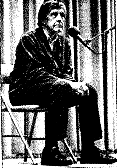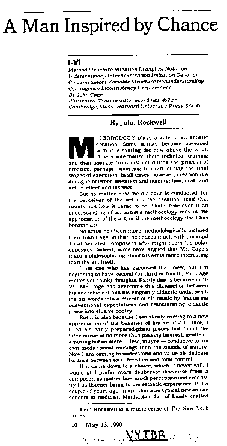"A Man Inspired by Chance"
a review of John Cage's I-VI
New York Times Book Review, May 13, 1990, p. 10



Method Structure Intention Discipline Notation Indeterminacy Interpenetration Imitation Devotion Circumstances Variable Structure Nonunderstanding Contingency Inconsistency Performance. By John Cage. Illustrated. Two cassette recordings. 452 pp. Cambridge, Mass.: Harvard University Press. $34.95.
By John Rockwell
METHODOLOGY plays a role in all artistic creation. Some artists become obsessed with it, elevating the how above the what. Others internalize their technical training and then operate from instinct during the process of creation, perhaps reverting to craft during the final stages of execution. In all cases, however, creation is a dialogue between intention and nonintention, craft and art, intellect and instinct.
But no matter how the dialogue is conducted, for the perceiver of the art it's the creation itself that counts, not how it came to be. That's true even if an understanding of an artist's methodology aids in the appreciation of the art, or if the methodology itself has become art.
No artist has been more methodologically inclined than John Cage; in that, he shares much with the rigid Total Serialist composers who might seem his polar opposites. Indeed, some have argued that Mr. Cage's mature philosophizing about his art is more interesting than the art itself.
I am one who has espoused that view, but I'm beginning to have second (or third or fourth; Mr. Cage makes you think) thoughts. Partly that is because in I - IV Mr. Cage has overcome this disjunction between his anarchic art and his elegantly didactic texts, bending his words into a mirror of his music by fracturing conventional expectations and transforming didactic prose into elusive poetry.
But it is also because I am slowly coming to a new appreciation of the beauties of his art itself. Once, I liked his early prepared - piano pieces but found the later music of no more than passing interest, gentle or amusing but no more - less, maybe - conducive to my own meditational musings than the sounds of nature. Now I am coming to understand and value his delicate balance between total freedom and total control.
If it came down to a choice, which it never will, I would still prefer more deliberate discourse from a composer, no matter how much perception and creativity I as listener bring to the esthetic experience. But a couple of years ago, in an otherwise typical new - music concert in midtown Manhattan, full of busily crafted scores in all the fashionable idioms of the day, a work by Mr. Cage, limpid and calm, came as an oasis, or better, as a leafy green park in a bustling city.
With all that in mind, we have Mr. Cage's latest artwork, a lavishly produced book of his six Charles Eliot Norton Lectures given at Harvard University during the 1988 - 89 academic year. It is a complex affair, in several layers. Central are the six actual "lectures," which Mr. Cage arranged as "mesostics," meaning vertical lines of capital letters (spelling out the various words of this book's subtitle) with horizontal lines of varying lengths extending in both directions from each letter and incorporating the letters into new words.
The horizontal lines are drawn from various "source texts," broken down by chance procedures (computer - aided "I Ching") and then further refined by Mr. Cage. In addition, the book offers an introduction by Mr. Cage in conventional prose, explaining his methods; the source texts themselves as an appendix, again in ordinary prose, ranging from his own writings to those of Wittgenstein, Joyce, Thoreau, Emerson, Buckminster Fuller, Marshall McLuhan, to passages about international affairs from newspapers.
Running along the bottom of each page are transcriptions of question - and - answer sessions with his Cambridge public. There are page - sized photographs of a Cage score. And there are two cassette recordings of Mr. Cage reading the fourth lecture and responding to his sometimes deferential, sometimes puzzled, sometimes testy questioners (these are clumsily packaged, between the book and its plastic shrink - wrap, leaving nowhere to put them once the wrap has been broken).
Although Mr. Cage has spent a lifetime attempting to break down preconceptions, most people still approach his work with their minds made up. Some think of him as a guru, a beatific holdover from the 1960's who dispenses Oriental wisdom to the Western unwashed. Others see him as an old - fashioned charlatan or, however benign his intentions, as a termite nibbling away at Western cultural values.
One thing that needs understanding, however, is that Mr. Cage is by no means an absolute anarchist. For him, everything only goes within limits set by him. It is he who determined the form of these lectures, chose the source texts, decided to use the "I Ching" in the way he uses it, edited its raw results, inserted pauses and arranged the text upon the page and, above all, who presented his work to the public, as a performer. In other words, Mr. Cage uses chance the way other artists have used alcohol or opium or inspirational walks in the woods. Chance frees his mind and loosens his creative flow. But it is still John Cage who is creating, not the "I Ching" and not the computer.
This book will prove frustrating for all those who know for a fact that anarchistic blather is bunk, and it may be taken as insulting when they recall Mr. Cage's distinguished predecessors in the Norton series (Stravinsky, Copland, Roger Sessions, even Leonard Bernstein among composers alone). But its multilayered structure makes it his most interesting textual creation since his first collection of essays, "Silence," in 1961.
His esthetic, philosophical message has not changed: we must abandon ourselves to the experience of life, create our own art through the sensations that surround us, participate in the unfolding of the universe gently and lovingly. But the mesostics provide the missing link between all his chance - derived music of the last 30 years and his texts, which have taken longer to catch up to the promises made by his music.
Especially when he reads them, in his frail but steadfast baritone, shaping the phrases and illuminating hidden meanings and poetic undercurrents in word jumbles that seem at first - and may still be, on the less important level of explication - meaningless, Mr. Cage attains a perfect synthesis of all that he is: softspoken backwoods storyteller, vanguard modernist, Zen master, kindly village preacher. Yet this is not mere accident: Mr. Cage is making art. And by any generous definition of what art is and can be, he is making beautiful music as well.
Document URL: http://www.english.upenn.edu/~afilreis/88/cage-nyt-review.html
Last modified: Wednesday, 18-Jul-2007 16:24:47 EDT